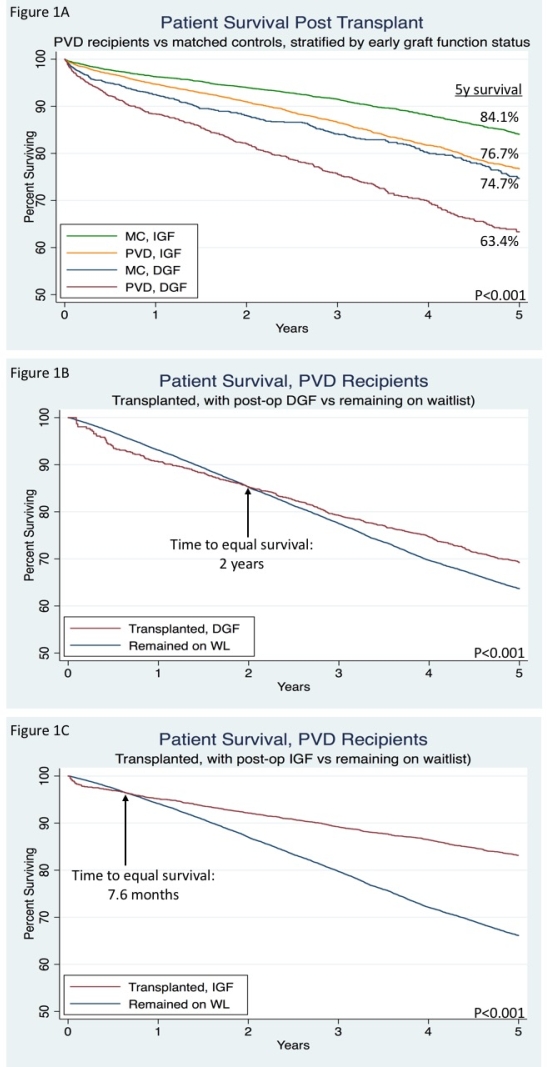Early Graft Function Correlates with Survival Benefit in Kidney Transplant Recipients with Peripheral Vascular Disease
NYU Langone Medical Center, New York, NY.
Meeting: 2018 American Transplant Congress
Abstract number: C45
Keywords: Kidney transplantation, Outcome, Peripheral vascular disease, Survival
Session Information
Session Name: Poster Session C: Kidney Donor Selection / Management Issues
Session Type: Poster Session
Date: Monday, June 4, 2018
Session Time: 6:00pm-7:00pm
 Presentation Time: 6:00pm-7:00pm
Presentation Time: 6:00pm-7:00pm
Location: Hall 4EF
Objective: Peripheral vascular disease (PVD) is common among end-stage renal disease (ESRD) patients and is a known independent risk factor for increased post-transplant mortality. The survival benefit of transplantation in these patients is not well understood. We report a retrospective analysis of post-transplant outcomes of PVD patients and hypothesized that favorable early graft function would correlate with favorable patient survival post-transplant.
Methods: Data were provided by the Scientific Registry of Transplant Recipients. Adult, kidney-only recipients transplanted between 1/1/2010-6/2/2017 were included. Survival comparisons were made between patients with PVD and controls without PVD matched for recipient and donor age, gender, and race, recipient obesity, diabetes, donor type, and cold ischemia time. Kaplan-Meier survival estimates were compared for statistical significance using log-rank tests. For survival benefit analyses, transplant recipients with PVD were compared to those with PVD who remained waitlisted. Post-transplant survival was treated as a time-dependent variable with patients contributing time to the waitlist cohort pre-transplant, and to the transplant cohort post-transplant.
Results: 7831 recipients with PVD were matched to controls (MC) without PVD. Post-transplant patient survival was significantly worse in the PVD cohort compared to MC at 1, 3, and 5 years (95.6% vs 93.4%, 90.1% vs 84.4%, 82.4% vs 74.1%, p<0.001). PVD recipients with immediate graft function (IGF) had worse survival than MC with IGF, but similar survival to MC with delayed graft function (DGF). PVD recipients with DGF had the worst long-term patient survival (Fig1A). PVD recipients with DGF only achieved survival benefit if they survived 2-years post-transplant (Fig1B). PVD recipients with IGF achieved survival benefit after 7.6-months post-transplant (Fig1C).
Conclusion: While PVD imparts known risks in patients being considered for transplant, with careful graft selection these patients can be expected to achieve favorable outcomes.
CITATION INFORMATION: Min E., Tatapudi V., Ali N., Gelb B., Dagher N., Benstein J., Montgomery R., Lonze B. Early Graft Function Correlates with Survival Benefit in Kidney Transplant Recipients with Peripheral Vascular Disease Am J Transplant. 2017;17 (suppl 3).
To cite this abstract in AMA style:
Min E, Tatapudi V, Ali N, Gelb B, Dagher N, Benstein J, Montgomery R, Lonze B. Early Graft Function Correlates with Survival Benefit in Kidney Transplant Recipients with Peripheral Vascular Disease [abstract]. https://atcmeetingabstracts.com/abstract/early-graft-function-correlates-with-survival-benefit-in-kidney-transplant-recipients-with-peripheral-vascular-disease/. Accessed December 20, 2025.« Back to 2018 American Transplant Congress

